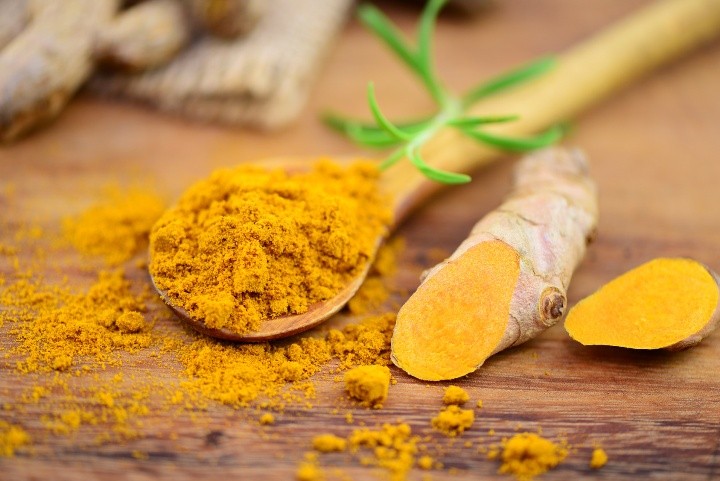Turmeric is a medicinal root and spice known for its vibrant yellow color and its healing properties. The root plays an essential role in Ayurveda, an ancient Indian holistic medical practice. While turmeric has been used for thousands of years to subdue inflammation, modern scientists have recently found it to possess anti-inflammatory and antioxidant properties[1].
While turmeric is often hailed as the healer, its healing powers may be attributed to curcumin, the root’s active component. A number of randomized control studies have revealed that curcumin effectively reduces the severity of pain in participants[2]. Curcumin is known as a COX-2 inhibitor. This means that curcumin counteracts the effects of COX-2, the enzyme responsible for inflammation[3]. More commonly known COX-2 inhibitors are aspirin and ibuprofen (i.e. Advil and Motrin)[4]. In fact, it provides remedy to many major inflammatory diseases such as arthritis, gastrointestinal diseases, and even reduces inflammatory mechanisms associated with the development of cancer[5].
The American College of Rheumatology conducted a study testing the effects of turmeric on rheumatoid arthritis—an autoimmune disease—and found that the curcumin-containing spice was effective in reducing the severity of pain, prompting a recommendation of turmeric supplements for treatment of rheumatoid arthritis[6]. Because arthritis is characterized by a chronic inflammation of the joints, the excessive production of COX-2 enzyme can be effectively counteracted by the inhibiting components of curcumin, thus eliminating rheumatoid symptoms of pain.
Curcumin similarly has a positive effect in the treatment of ulcerative colitis, also known as inflammatory bowel disease. Curcumin’s anti-inflammatory characteristics reduce the secretion of bile from the stomach, as it binds to the enzymes that induce inflammation within the stomach. These enzymes have an inflammatory effect on the esophagus, which may have long-term consequences if not treated[7]. Curcumin essentially reverses the effects this inflammatory condition.
Al in all, turmeric—especially its most potent component, curcumin—have been shown to have extraordinary healing and anti-inflammatory properties that relieve the most painful autoimmune and inflammatory diseases. Turmeric has the potential to effectively eliminate or greatly ameliorate the symptoms of many conditions by attacking them at their roots—the source of inflammation.
Turmeric does not have to be exclusively saved for the treatment of major diseases. There are ways to incorporate the root into everyday use as a preventative measure or to subdue minor inflammation in the body, as diverse as skin issues to minor joint pain to indigestion. Turmeric has a low rate of absorption in the body, however taking the spice with fats or oils, black pepper, and other herbs and spices can help improve the rate of absorption. Add the spice to your favorite recipes! Maybe sprinkle it on eggs or add some to your daily tea! These small changes can have a major effect on your overall health and help to reduce and prevent inflammation and ultimately, inflammatory diseases.
—
This article was contributed by Mary Ney.
Mary is a first year student at American University in Washington, DC where she is studying public health. She is originally from Ocean City, New Jersey. Mary has been practicing yoga for over four years and has a passion for wellness, running, and healthy foods.
—
References:
[1] Aggarwal, BB, Sundaram, C, et al. (2007). Curcumin: The Indian solid gold. Adv Exp Med Biol: 595, 1-75. Retrived 4 February 2016 from http://www.ncbi.nlm.nih.gov/pubmed/17569205
[2] Sahebkar, A. & Henrotin, Y. (14 Dec 2015). Analgesic Efficacy and safety of Curcuminoids in clinical practice: A systematic review and meta-analysis of randomized control trials. Pain Med. Retrived from http://www.ncbi.nlm.nih.gov/pubmed/26814259
[3] Rao, CV. (2007). Regulation of COX and LOX by curcumin. Avd Exp Med Biol, 595: 213-264. Retrived from: http://www.ncbi.nlm.nih.gov/pubmed/17569213
[4] (2 February 2015). Cox-2 inhibitors. MedicineNet.com. Retrieved 4 February 2016 from http://www.medicinenet.com/cox-2_inhibitors/article.htm
[5] Jurenka, JS. (September 2009). Anti-inflammatory properties of surcumin, a major constituent of Curcuma longa: a review of preclinical and clinical research. Alternative Medicine Review, 14(3):277. Retrived 4 February 2016 from http://www.altmedrev.com/publications/14/2/141.pdf
[6] Funk, JL, et al. (2006). Efficacy and mechanism of action of turmeric supplements in the treatment of experimental arthritis. American College of Rheumatology, 54(11): 3452-3464. Retrived 4 February 2016 from http://onlinelibrary.wiley.com/doi/10.1002/art.22180/epdf . DOI: 10.1002.
[7] Ke, F, Yadav, PK, & LZ Ju. (Jan-Feb 2012). Herbal medicine in the treatment of ulcerative colitis. The Saudi Journal of Gastroenterology, 18(1): 3-10. Retrived 4 February 2016 from http://www.ncbi.nlm.nih.gov/pmc/articles/PMC3271691/. DOI: 10.4103/1319-3767.91726
Photo Credit: http://bebrainfit.com/wp-content/uploads/2015/09/turmeric-spoon-root-720×481.jpg



